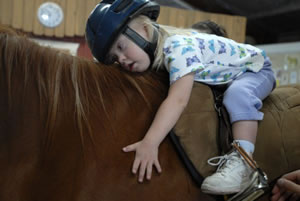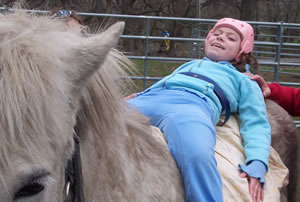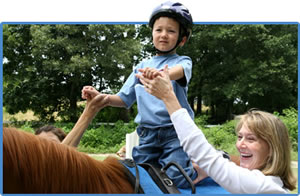|
MORE
THAN YOUR USUAL THERAPY REGIMEN
Written
by:Renee
Berens, student, University of Florida
 Though
horses have been used for generations
mainly for merely carrying around carts
and people, used in shows for entertainment,
and pleasure riding, mounting research
has shown an innovative program in the
equine industry. From age to age, various
past research projects have pursued
the thoughts that today make up the
more widely used Hippotherapy,
a style of Equine-Assisted Therapy (EAT)
utilized by various therapists across
the board. Hippotherapy is a term that
means a treatment program implemented
by using a horse for a therapeutic goa.
These goals are typically “physical,
psychological, cognitive, behavioral,
and/or functionally” oriented.
This therapy regimen is classified by
the American Hippotherapy Association,
AHA, as a program that can be utilized
by a Physical Therapist, an Occupational
one, or a Speech- Language Pathologist
for their intended habilitative or rehabilitative
purposes and goals. Though
horses have been used for generations
mainly for merely carrying around carts
and people, used in shows for entertainment,
and pleasure riding, mounting research
has shown an innovative program in the
equine industry. From age to age, various
past research projects have pursued
the thoughts that today make up the
more widely used Hippotherapy,
a style of Equine-Assisted Therapy (EAT)
utilized by various therapists across
the board. Hippotherapy is a term that
means a treatment program implemented
by using a horse for a therapeutic goa.
These goals are typically “physical,
psychological, cognitive, behavioral,
and/or functionally” oriented.
This therapy regimen is classified by
the American Hippotherapy Association,
AHA, as a program that can be utilized
by a Physical Therapist, an Occupational
one, or a Speech- Language Pathologist
for their intended habilitative or rehabilitative
purposes and goals.
Rather than merely acquainting the
patients with horses, Hippotherapy is
primarily used as a tool by which to
teach and retrain the patient’s
“neuromuscular response”
by exposing them to the movements made
by the specially trained horse. By specially
trained, it is understood that the horse
must be well-tempered and trained to
cope with various distractions so that
both the protection of the patient,
as well as other parties involved, is
maintained.
Patients can fall into numerous age
categories, beginning as “early
as 18 to 24 months,” although
it is recommended that the candidate
be able to handle the movement of the
horse by having enough personal control
over their trunk and head and continuing
upwards as far as those treating them
can handle. Beginning each session the
patient gets up onto the horse, where
he/she passively interacts and is influenced
by the movements of the horse. Typically,
the patient is lacking the support from
the stirrups, and is in a forward, backward,
supinated (lying on back), pronated
(lying face down), or standing position.
Most importantly throughout the patient’s
session is watching the positioning
of that patient so as to utilize the
horse’s motions for maximum effect.
 In
accordance with increasing amounts of
research, it has been shown that the
gait of a human is similar to that of
a horse, and it is this similarity that
when the horse’s pelvis moves
during various intensities of exercise,
the horse’s movements can be used
to impact the patient’s “muscle
tone, balance, posture, flexibility,
coordination, and motor development”
as well as “improve respiratory
and motor control of speech.”
Other than these more physically related
areas, having the patient interact with
not only their therapist, but also with
the horse, can help overall psychosocial
and emotional well being by increasing
their personal “self-confidence,
self- esteem, and self-awareness”
levels. Though each, the Physical Therapist,
Occupational Therapist, and Speech –
Language Pathologist, have differing
agendas for their patients, the one
unifying umbrella goal is to increase
the individual’s trunk strength. In
accordance with increasing amounts of
research, it has been shown that the
gait of a human is similar to that of
a horse, and it is this similarity that
when the horse’s pelvis moves
during various intensities of exercise,
the horse’s movements can be used
to impact the patient’s “muscle
tone, balance, posture, flexibility,
coordination, and motor development”
as well as “improve respiratory
and motor control of speech.”
Other than these more physically related
areas, having the patient interact with
not only their therapist, but also with
the horse, can help overall psychosocial
and emotional well being by increasing
their personal “self-confidence,
self- esteem, and self-awareness”
levels. Though each, the Physical Therapist,
Occupational Therapist, and Speech –
Language Pathologist, have differing
agendas for their patients, the one
unifying umbrella goal is to increase
the individual’s trunk strength.
With all of this in mind, the therapist
creates a regimen consisting of numerous
terrain styles so that the patient experiences
all of the horse’s different back
movements. Each of these terrains provides
differing motions that transfer to the
rider’s torso, replicating a movement
similar to “passive joint mobilization
in the hip joint and lower spine”
(Kastner &
Burroughs, 1993, p.111). Good
posture for the patient typically consists
of 90 degree angles at both the hips
and knees; as stressed earlier, this
degree of motion is especially important
during these sessions so that the horse’s
motions can be used to help increase
blood circulation, which in turn also
helps to increase levels of mobility,
relax muscles, and decrease muscle spasticity.
The combined effect of all this allows
for the patient to feel, what is classified
as, a normal walking experience as well
as help to raise muscular motion control
to a more automatic level, since their
torso is “more stable while on
the horse.” Another unique aspect
of Hippotherapy is that while riding
the horse, a patient with an “attention-
deficit disorder is noted to have a
lengthening of attention span and focus,”
unlike that seen in their usual environments.
 Besides
varying the terrain, the therapist can
“change the horse’s tempo
and direction,” experiment with
differing positions including transitional
ones in between, make the patient close
their eyes to “increase vestibular
input,” and also use various pieces
of equipment, such as the stirrups,
balls, and bean bags to help increase
the range of the motions being activated
and assist in the previously mentioned
goals of increasing trunk strength as
well as attention span. Through providing
these differing situations for the patient
while riding, the patient has to learn
to control and adapt his/her body’s
spatial positioning in order to maintain
the correct posture, which is constantly
being enforced by the therapist. Also
enforced is the goal of learning problem-solving
skills, and, in many ways, learning
and teaching their muscles the correct
sequencing for events. Besides
varying the terrain, the therapist can
“change the horse’s tempo
and direction,” experiment with
differing positions including transitional
ones in between, make the patient close
their eyes to “increase vestibular
input,” and also use various pieces
of equipment, such as the stirrups,
balls, and bean bags to help increase
the range of the motions being activated
and assist in the previously mentioned
goals of increasing trunk strength as
well as attention span. Through providing
these differing situations for the patient
while riding, the patient has to learn
to control and adapt his/her body’s
spatial positioning in order to maintain
the correct posture, which is constantly
being enforced by the therapist. Also
enforced is the goal of learning problem-solving
skills, and, in many ways, learning
and teaching their muscles the correct
sequencing for events.
Currently, there are a multitude of
disorders each with its own particular
needs in which the therapist is striving
to positively affect and conquer the
Five Developmental Objectives of Physical
Education: Organic, Neuromuscular, Interpretive,
Social, and Emotional (Stopka
& Todorovich, 2005) through
the use of a Hippotherapy regimen. Hippotherapy
has been applied to a number of widespread
disorders including, “but not
limited to: Cerebral Palsy, Autism Spectrum
Disorders, Multiple Sclerosis, Spinal
Cord Injuries, Down Syndrome, Spina
Bifida, Brain Injuries, Cardiovascular
accidents/Stroke, and Attention Deficit
Disorders” (Bender,
2008).
Horses
Helping People, H.O.P.E, is a local
Equine-Assisted Therapy program run
by Physical and Occupational Therapists
that utilizes Hippotherapy. For the
past several months, horses have become
an increasingly distinguished aspect
of my life. Though I have minimal experience
with them, their presence has not only
benefited my confidence with them, but
has also increased my awareness of all
that their vibrant personalities can
be used for. While out there volunteering,
I have seen many children benefit from
this program, but a few children stand
out prominently in my mind. Two of these
children have forms of Autism and one
has Duchenne’s Muscular Dystrophy.
Much like the exercises and games previously
stated, we use bean bags and balls to
play games where the child has to toss
them into a cone, or at a target, to
help increase their fine motor control
for both unilateral and contralateral
movements.
 These
games help in both cases for the child
with Duchenne’s Muscular Dystrophy
(DMD) as well as with the two children
with Autism. Duchenne’s
Muscular Dystrophy is a “progressive
weakness and wasting of skeletal muscle”
(Stopka &
Todorovich, 2005, p. 32), and
so by having this child participate
in these exercises and stretches, we
help to continue exercising the muscles
and strengthening them. Though the process
of muscle wasting is irreversible, the
child I have watched has increased his
neuromuscular strength and endurance,
which will allow him to maintain his
mobility as long as possible. In contrast
to the disorder DMD, Autism
is a developmental spectrum disorder
affecting the person’s responses
and movements, ranging from mild to
severe cases. With this disorder, the
person can exhibit a variety of symptoms
within the categories of “communication,
social interaction, sensory impairment,
play, and behaviors.” These
games help in both cases for the child
with Duchenne’s Muscular Dystrophy
(DMD) as well as with the two children
with Autism. Duchenne’s
Muscular Dystrophy is a “progressive
weakness and wasting of skeletal muscle”
(Stopka &
Todorovich, 2005, p. 32), and
so by having this child participate
in these exercises and stretches, we
help to continue exercising the muscles
and strengthening them. Though the process
of muscle wasting is irreversible, the
child I have watched has increased his
neuromuscular strength and endurance,
which will allow him to maintain his
mobility as long as possible. In contrast
to the disorder DMD, Autism
is a developmental spectrum disorder
affecting the person’s responses
and movements, ranging from mild to
severe cases. With this disorder, the
person can exhibit a variety of symptoms
within the categories of “communication,
social interaction, sensory impairment,
play, and behaviors.”
Although both of these disorders are
quite different and could be discussed
in much greater length, H.O.P.E.,
like other Hippotherapy programs, does
use techniques that parallel those previously
discussed such as throwing, kneeling
on the horse, reaching, and other movements
to create some pretty impressive progress
for the patients. Of the two children
that I have worked with that have differing
forms of Autism, one is extremely indecisive
whilst the other is overly opinionated,
and whom I believe to have a more severe
form of Autism. Through this regimen,
the indecisive child has been observed
to have a spike in self-confidence,
evident in all of his mannerisms. The
opinionated child has become more cooperative
and willing to participate in activities
for longer periods of time, showing
an increase in attention span. All three
of these children have been key examples
to me of what the future can hold for
them as long as they stick to these
beneficial routines.
Hippotherapy is just one unique style
of therapy that has immense potential.
H.O.P.E. is merely a local Hippotherapy
program, but others like it can introduce
all that horses have to offer beyond
their typical usage. With this, one
can truly say that the power of animals
need not be overlooked. As continuing
research mounts and is collected, one
can see more and more the doors that
alternative medicine is opening. It
is with these innovations that traditional
and alternative medicine can unite with
one common goal for the future: to accomplish
the best for the patient.
references
resources:
|



